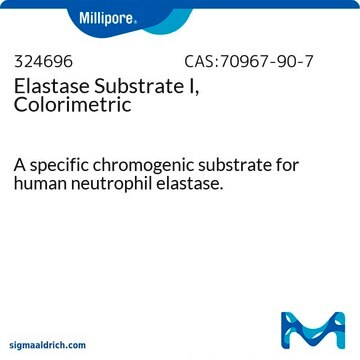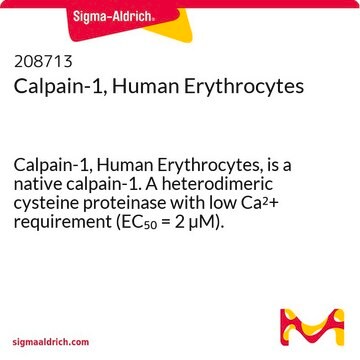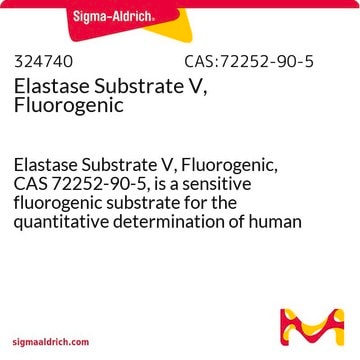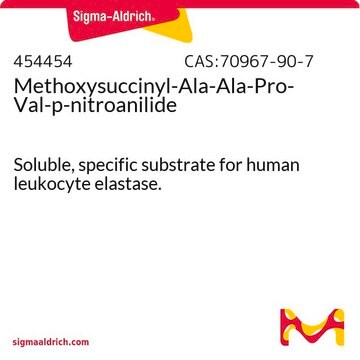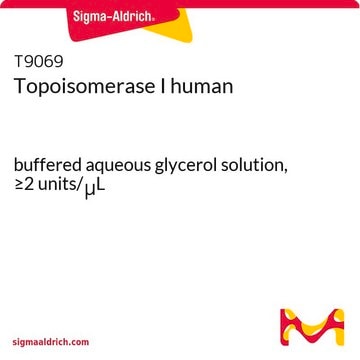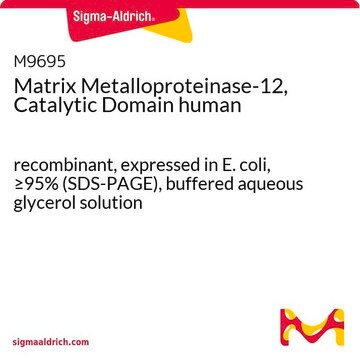This form of neutrophil elastase is a salt-free preparation and is supplied in an active form with a specific activity of ≥20 units/mg protein. It is not sterile and has not been tested for cell culture applications. To use it in a cell culture assay, sterile filtration is necessary, which may result in some product retention on the filter.
324681
Elastase, Human Neutrophil
Elastase, Human Neutrophil, CAS 9004-06-2, is a serine protease that degrades elastin, collagen, and proteoglycans
Synonym(s):
Elastase, Human Neutrophil
Select a Size
Select a Size
About This Item
Recommended Products
Quality Level
description
Merck USA index - 14, 3535
form
lyophilized solid
specific activity
≥20 units/mg protein
manufacturer/tradename
Calbiochem®
storage condition
OK to freeze
shipped in
ambient
storage temp.
−20°C
General description
Warning
Unit Definition
Physical form
Preparation Note
Reconstitution
Analysis Note
Other Notes
Junger, W.G., et al. 1992. Biol. Chem. Hoppe-Seyler 373, 691.
Selak, M.A. 1992. Thromb. Haemost.68, 570.
Baugh, R.J., and Travis, J. 1976. Biochemistry15, 836.
Legal Information
Signal Word
Danger
Hazard Statements
Precautionary Statements
Hazard Classifications
Eye Irrit. 2 - Resp. Sens. 1 - Skin Irrit. 2 - STOT SE 3
Target Organs
Respiratory system
Storage Class Code
11 - Combustible Solids
WGK
WGK 3
Flash Point(F)
Not applicable
Flash Point(C)
Not applicable
Certificates of Analysis (COA)
Search for Certificates of Analysis (COA) by entering the products Lot/Batch Number. Lot and Batch Numbers can be found on a product’s label following the words ‘Lot’ or ‘Batch’.
Already Own This Product?
Find documentation for the products that you have recently purchased in the Document Library.
Customers Also Viewed
-
Hi Is this form of neutrophil elastase active and suitable be used directly in a cell assay? And is it sterile ? Mvh Magdalena
1 answer-
Helpful?
-
-
Has this product been tested for the presence of endotoxin?
1 answer-
Unfortunately, this product has not been tested for the presence for endotoxins
Helpful?
-
-
what is the molecular wight of the enzyme ?
1 answer-
Unfortunately, the molecular weight has not been determined for this product. A number of estimates have been reported in the literature. Please see the link below to a publication that may be helpful:
https://www.sciencedirect.com/science/article/pii/S1016847823175091?via%3DihubHelpful?
-
-
Is this the active form of the enzyme? or does it require activation by cathepsin?
1 answer-
Here are the recommended reconstitution and reaction conditions:
Solubility information:
Reconstitute in 50 mM sodium acetate, pH 5.5, with 200 mM NaCl or in other aqueous buffers. Material is most active near a neutral pH, but to maintain stability upon reconstitution, use in a slightly acidic buffer (pH 5.5) to avoid autolysis.
Following reconstitution, aliquot and freeze (-20°C) for long term storage or refrigerate (4°C) for short-term storage. Acidic stock solutions are stable for up to 1 month at 4°C or for up to 1 year at -20°C.Human Neutrophil Elastase Protocol
1. Dissolve enzyme in reaction buffer: 100 mM Tris-HCl, pH 7.5, 500 mM NaCl.
2. Prepare the substrate stock solution by dissolving Elastase Substrate I (MeOSuc-Ala-Ala-Pro-Val-pNA, Cat. No. 324696) at 50 mM in DMSO.
3. Just prior to assay, dilute the substrate stock solution with an equal volume of 200 mM Tris-HCl, pH 8.0. Mix well.
4. Prepare the assay mixture by combining 960 µl of reaction buffer with 40 µl of diluted substrate stock solution.
5. Add enzyme to assay mixture, mix, and incubate at 25°C.
6. Monitor the change in absorbance at 410 nm. Use an ε of 8800 at 410 nm to calculate the hydrolysis of nitroanilide.Helpful?
-
Active Filters
Our team of scientists has experience in all areas of research including Life Science, Material Science, Chemical Synthesis, Chromatography, Analytical and many others.
Contact Technical Service
